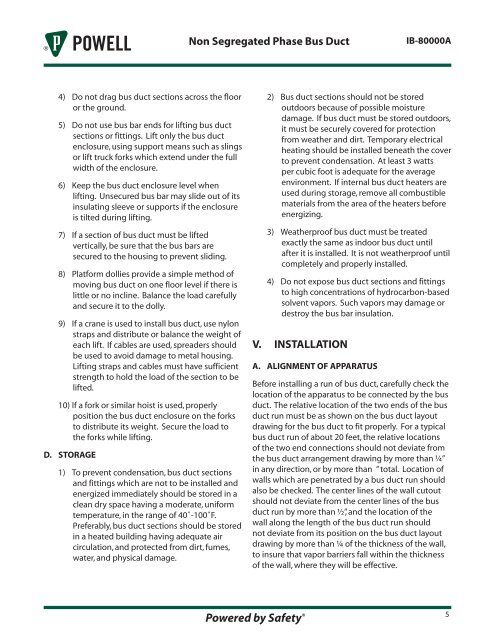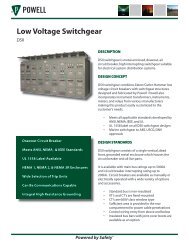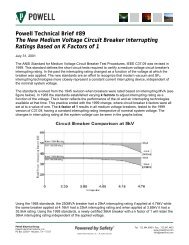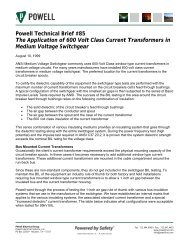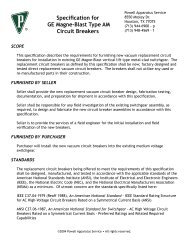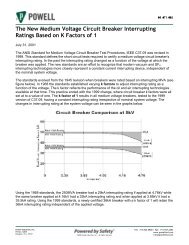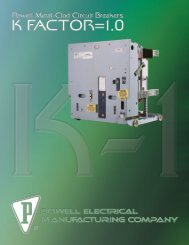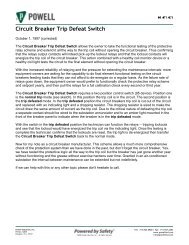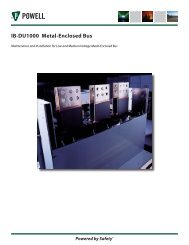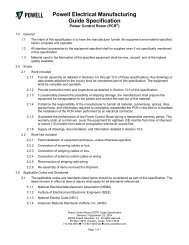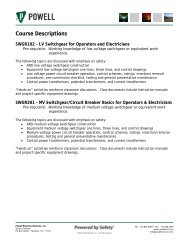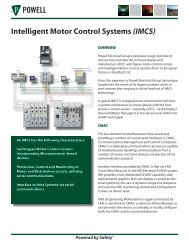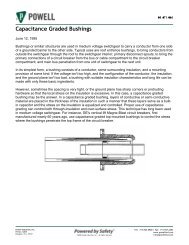IB-80000A Non Segregated Phase Bus Duct - Powell Industries, Inc.
IB-80000A Non Segregated Phase Bus Duct - Powell Industries, Inc.
IB-80000A Non Segregated Phase Bus Duct - Powell Industries, Inc.
Create successful ePaper yourself
Turn your PDF publications into a flip-book with our unique Google optimized e-Paper software.
<strong>Non</strong> <strong>Segregated</strong> <strong>Phase</strong> <strong>Bus</strong> <strong>Duct</strong><strong>IB</strong>-<strong>80000A</strong>4) Do not drag bus duct sections across the flooror the ground.5) Do not use bus bar ends for lifting bus ductsections or fittings. Lift only the bus ductenclosure, using support means such as slingsor lift truck forks which extend under the fullwidth of the enclosure.6) Keep the bus duct enclosure level whenlifting. Unsecured bus bar may slide out of itsinsulating sleeve or supports if the enclosureis tilted during lifting.7) If a section of bus duct must be liftedvertically, be sure that the bus bars aresecured to the housing to prevent sliding.8) Platform dollies provide a simple method ofmoving bus duct on one floor level if there islittle or no incline. Balance the load carefullyand secure it to the dolly.9) If a crane is used to install bus duct, use nylonstraps and distribute or balance the weight ofeach lift. If cables are used, spreaders shouldbe used to avoid damage to metal housing.Lifting straps and cables must have sufficientstrength to hold the load of the section to belifted.10) If a fork or similar hoist is used, properlyposition the bus duct enclosure on the forksto distribute its weight. Secure the load tothe forks while lifting.D. STORAGE1) To prevent condensation, bus duct sectionsand fittings which are not to be installed andenergized immediately should be stored in aclean dry space having a moderate, uniformtemperature, in the range of 40˚-100˚F.Preferably, bus duct sections should be storedin a heated building having adequate aircirculation, and protected from dirt, fumes,water, and physical damage.2) <strong>Bus</strong> duct sections should not be storedoutdoors because of possible moisturedamage. If bus duct must be stored outdoors,it must be securely covered for protectionfrom weather and dirt. Temporary electricalheating should be installed beneath the coverto prevent condensation. At least 3 wattsper cubic foot is adequate for the averageenvironment. If internal bus duct heaters areused during storage, remove all combustiblematerials from the area of the heaters beforeenergizing.3) Weatherproof bus duct must be treatedexactly the same as indoor bus duct untilafter it is installed. It is not weatherproof untilcompletely and properly installed.4) Do not expose bus duct sections and fittingsto high concentrations of hydrocarbon-basedsolvent vapors. Such vapors may damage ordestroy the bus bar insulation.V. INSTALLATIONA. ALIGNMENT OF APPARATUSBefore installing a run of bus duct, carefully check thelocation of the apparatus to be connected by the busduct. The relative location of the two ends of the busduct run must be as shown on the bus duct layoutdrawing for the bus duct to fit properly. For a typicalbus duct run of about 20 feet, the relative locationsof the two end connections should not deviate fromthe bus duct arrangement drawing by more than ¼”in any direction, or by more than ” total. Location ofwalls which are penetrated by a bus duct run shouldalso be checked. The center lines of the wall cutoutshould not deviate from the center lines of the busduct run by more than ½”, and the location of thewall along the length of the bus duct run shouldnot deviate from its position on the bus duct layoutdrawing by more than ¼ of the thickness of the wall,to insure that vapor barriers fall within the thicknessof the wall, where they will be effective.Powered by Safety ® 5


